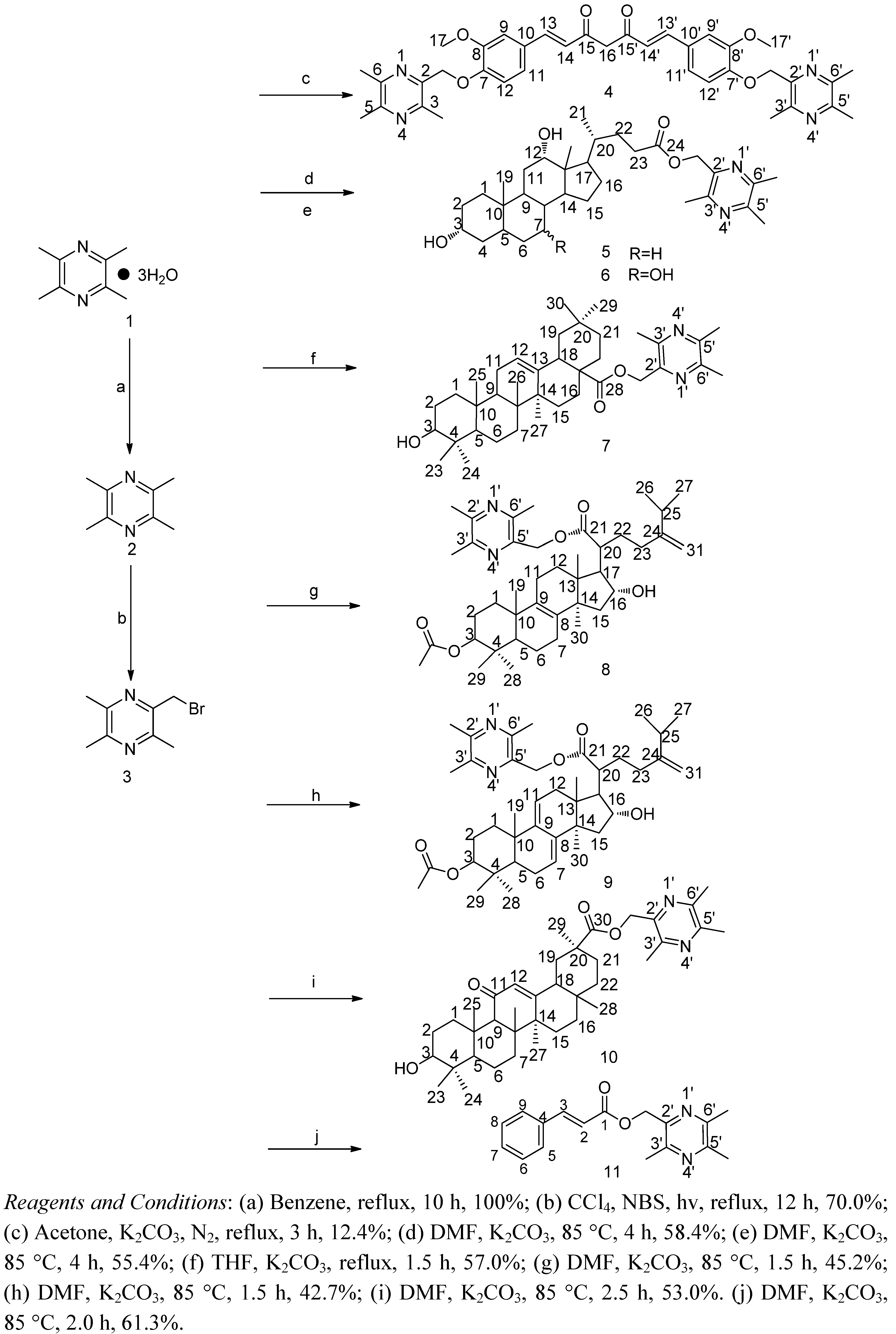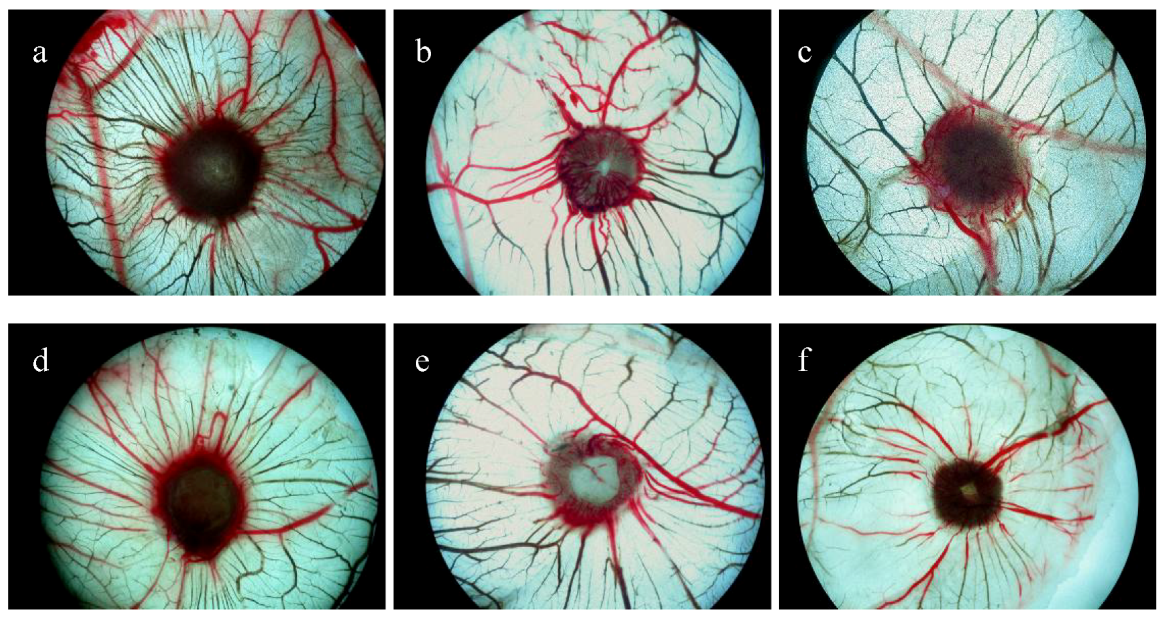Synthesis and Biological Evaluation of New Ligustrazine Derivatives as Anti-Tumor Agents
Abstract
:1. Introduction
2. Results and Discussion
2.1. Chemistry

2.2. Biological Activities
2.2.1. MTT Test
| Compound | IC50 (μg/mL) | ||||
|---|---|---|---|---|---|
| Bel 7402 | A549 | HCT-8 | BGC-823 | A2780 | |
| TMP, DA, CA, OA, GA, CIA, PA and DPA | — a | — | — | — | — |
| CU | 6.496 | 6.521 | 6.278 | 6.806 | 6.520 |
| 4 | 6.391 | 5.890 | 7.106 | 5.472 | 5.540 |
| 5 | 8.012 | 6.688 | 7.426 | 6.660 | 6.619 |
| 6 | — | — | — | — | — |
| 7 | 7.611 | — | 9.273 | — | — |
| 8 | — | — | — | — | — |
| 9 | — | 8.770 | — | — | — |
| 10 | — | — | — | — | — |
| 11 | 9.400 | 7.833 | — | — | — |
2.2.2. Angiogenesis Activity

| Compound | Control (  ± s) ± s) | Treatment (  ± s) ± s) | Dose (μg/egg) |
|---|---|---|---|
| 4 | 10.0 ± 2.19 | 3.8 ± 2.79 ** | 10 |
| 4 | 10.0 ± 2.19 | 1.4 ± 1.22 ** | 40 |
| 5 | 12.5 ± 2.59 | 4.8 ± 3.71 ** | 10 |
| 5 | 12.5 ± 2.59 | 7.5 ± 3.40 * | 40 |
| 6 | 9.0 ± 2.68 | 6.2 ± 2.40 | 10 |
| 6 | 9.0 ± 2.68 | 5.7 ± 2.07 | 40 |
| 7 | 12.5 ± 2.59 | 12.0 ± 2.90 | 10 |
| 7 | 12.5 ± 2.59 | 9.5 ± 4.55 | 40 |
| 8 | 12.5 ± 2.59 | 9.7 ± 3.98 | 10 |
| 8 | 12.5 ± 2.59 | 10.8 ± 5.12 | 40 |
| 9 | 8.67 ± 1.03 | 7.7 ± 2.16 | 10 |
| 9 | 8.67 ± 1.03 | 5.7 ± 1.21 | 40 |
| 10 | 10.3 ± 1.50 | 9.5 ± 1.76 | 10 |
| 10 | 10.3 ± 1.50 | 9.8 ± 2.14 | 40 |
| 11 | 17.7 ± 5.28 | 10.3 ± 2.73 | 10 |
| 11 | 17.7 ± 5.28 | 7.0 ± 3.03 * | 40 |
2.2.3. Acute Toxicity
3. Experimental
3.1. Chemistry
3.2. Bio-Evaluation Methods
3.2.1. Cytotoxicity Evaluation

3.2.2. Angiogenesis Assay
3.2.3. Acute Toxicity
4. Conclusions
Supplementary Materials
Acknowledgments
- Sample Availability: Samples of the compounds 4–11 are available from the authors.
References and Notes
- Fialho, A.M.; Gupta, T.K.D.; Chakrabarty, A.M. Designing promiscuous drugs? Look at what nature made. Lett. Drug Des. Discov. 2007, 4, 40–43. [Google Scholar] [CrossRef]
- Wu, D.H.; Xu, X.J. A new practice: Study on the molecular mechanism of traditional Chinese medicine by computational pharmacology methods: Part 1: Pharmacokinetic modeling and chemical space distribution. Lett. Drug Des. Discov. 2011, 8, 652–658. [Google Scholar] [CrossRef]
- Wu, D.H.; Xu, X.J.; Zhang, M.Z.; Wang, L. A new practice: Study on the molecular mechanism of traditional Chinese medicine by computational pharmacology methods: Part 2: Pharmacodynamic modeling and distribution on ligand-target space of effective components. Lett. Drug Des. Discov. 2011, 8, 1009–1014. [Google Scholar] [CrossRef]
- Efferth, T.; Li, P.C.; Konkimalla, V.S.; Kaina, B. From traditional Chinese medicine to rational cancer therapy. Trends Mol. Med. 2007, 13, 353–361. [Google Scholar] [CrossRef]
- Wang, C.; Cao, B.; Liu, Q.Q.; Zou, Z.Q.; Liang, Z.A.; Gu, L.; Dong, J.P.; Liang, L.R.; Li, X.W.; Hu, K.; et al. Oseltamivir compared with the Chinese traditional therapy maxingshigan-yinqiaosan in the treatment of H1N1 influenza: A randomized trial. Ann. Intern. Med. 2011, 155, 217–225. [Google Scholar]
- Dennis, N. The new face of traditional Chinese medicine. Science 2003, 299, 188–190. [Google Scholar] [CrossRef]
- Zhang, J.L.; Wang, H.; Pi, H.F.; Ruan, H.L.; Zhang, P.; Wu, J.Z. Structural analysis and antitussive evaluation of five novel esters of verticinone and bile acids. Steroids 2009, 74, 424–434. [Google Scholar] [CrossRef]
- Zhang, J.L.; Wang, H.; Chen, C.; Pi, H.F.; Raun, H.L.; Zhang, P.; Wu, J.Z. Addictive evaluation of cholic acid-verticinone ester, a potential cough therapeutic agent with agonist action of opioid receptor. Acta Pharmacol. Sin. 2009, 30, 559–566. [Google Scholar] [CrossRef]
- Hao, Y.Z.; Wang, P.L.; Hong, Y.; Lei, H.M. Synthesis and structure identification of tetramethylpyrazine-protocatechuic acid and effects on hypoxic-ischemic brain damage. Pharmacol. Clin. Chin. Mater. Med. 2010, 26, 41–45. [Google Scholar]
- Ni, M.; Chen, Z.S.; Peng, Y.H. Clinical study of intraperitoneal chemotherapy plus Shiquandabu drink on advanced gastric cancer. Chin. Clin. Oncol. 2005, 10, 288–290. [Google Scholar]
- Guo, G.; Xu, J.H. Study of Shiquandabu decoction’s effecting on inhibit tumor invasion and metastasis. Glob. Tradit. Chin. Med. 2011, 4, 74–79. [Google Scholar]
- Yin, J.; Yu, C.; Yang, Z.; He, J.L.; Chen, W.J.; Liu, H.Z.; Li, W.M.; Liu, H.T.; Wang, Y.X. Tetramethylpyrazine inhibits migration of SKOV3 human ovarian carcinoma cells and decreases the expression of interleukin-8 via the ERK1/2, p38 and AP-1 signaling pathways. Oncol. Rep. 2011, 26, 671–679. [Google Scholar]
- Kunnumakkara, A.B.; Anand, P.; Aggarwal, B.B. Curcumin inhibits proliferation, invasion, angiogenesis and metastasis of different cancers through interaction with multiple cell signaling proteins. Cancer Lett. 2008, 269, 199–225. [Google Scholar] [CrossRef]
- Bill, M.A.; Bakan, C.; Benson, D.M.J.; Fuchs, J.; Young, G.; Lesinski, G.B. Curcumin induces proapoptotic effects against human melanoma cells and modulates the cellular response to immunotherapeutic cytokines. Mol. Cancer Ther. 2009, 8, 2726–2735. [Google Scholar] [CrossRef]
- Martinez, J.D.; Stratagoules, E.D.; LaRue, J.M.; Powell, A.A.; Gause, P.R.; Craven, M.T.; Payne, C.M.; Powell, M.B.; Gerner, E.W.; Earnest, D.L. Different bile acids exhibit distinct biological effects: The tumor promoter deoxycholic acid induces apoptosis and the chemopreventive agent ursodeoxycholic acid inhibits cell proliferation. Nutr. Cancer 1998, 31, 111–118. [Google Scholar] [CrossRef]
- Wu, Z.; Lü, Y.; Wang, B.; Liu, C.; Wang, Z.R. Effects of bile acids on proliferation and ultrastructural alteration of pancreatic cancer cell lines. World J. Gastroenterol. 2003, 9, 2759–2763. [Google Scholar]
- Zhang, P.X.; Li, H.M.; Chen, D.; Ni, J.H.; Kang, Y.M.; Wang, S.Q. Oleanolic acid induces apoptosis in human leukemia cells through caspase activation and poly (ADP-ribose) polymerase cleavage. Acta Bioch. Bioph. Sin. 2007, 39, 803–809. [Google Scholar] [CrossRef]
- Gapter, L.; Wang, Z.; Glinski, J.; Ng, K.Y. Induction of apoptosis in prostate cancer cells by pachymic acid from Poria cocos. Biochem. Biophys. Res. Commun. 2005, 332, 1153–1161. [Google Scholar] [CrossRef]
- Li, G.; Xu, M.L.; Lee, C.S.; Woo, M.H.; Chang, H.W.; Son, J.K. Cytotoxicity and DNA topoisomerases inhibitory activity of constituents from the sclerotium of Poria cocos. Arch. Pharm. Res. 2004, 27, 829–833. [Google Scholar] [CrossRef]
- Ekmekcioglu, C.; Feyertag, J.; Marktl, W. Cinnamic acid inhibits proliferation and modulates brush border membrane enzyme activities in Caco-2 cells. Cancer Lett. 1998, 128, 137–144. [Google Scholar] [CrossRef]
- Abe, H.; Ohya, N.; Yamamoto, K.F.; Shibuya, T.; Arichi, S.; Odashima, S. Effects of glycyrrhizin and glycyrrhetinic acid on growth and melanogenesis in cultured B16 melanoma cells. Eur.J. Cancer Clin. Oncol. 1987, 23, 1549–1555. [Google Scholar] [CrossRef]
- Ding, M.Y.; Luo, S.Z.; Liu, H.; Chen, P.R.; Liu, D.L. Determination of tetramethylpyrazine in animal serum and cerebrospinal fluid by high performance liquid chromatography. Chin. J. Chrom. 2000, 18, 46–48. [Google Scholar]
- Li, Q.Y.; Gao, Y.; Qiu, W.; Zu, Y.G.; Su, L.; He, W.N.; Deng, X.Q. Synthesis and anti-tumor activity of novel camptothecin-bile acid analogues. Lett. Drug Des. Discov. 2011, 8, 698–703. [Google Scholar] [CrossRef]
- Lei, H.M.; Li, Q.; Wang, P.L. Synthesis and Application of Anticancer Agents (LQC-Y). Patent PCT/CN2011/081530, 28 October 2011. [Google Scholar]
- Lei, H.M.; Li, Q.; Wang, P.L. Preparation and Application of Agents (LQC-X) for Treatment Ischemic Brain Injury and Its Sequelae. Patent PCT/CN2011/081528, 28 October 2011. [Google Scholar]
- Liu, X.Y.; Zhang, R.; Xu, W.F.; Li, C.W.; Zhao, Q.Q.; Wang, X.P. Synthesis of the novel liqustrazine derivatives and their protective effect on injured vascular endothelial cell damaged by hydrogen peroxide. Bioorg. Med. Chem. Lett. 2003, 13, 2123–2126. [Google Scholar] [CrossRef]
- Tai, T.; Shingu, T.; Kikuchi, T.; Tezuka, Y.; Akahori, A. Isolation of lanostane-type triterpene acids having an acetoxyl group from sclerotia of Poria cocos. Phytochemistry 1995, 40, 225–231. [Google Scholar]
- Folkman, J. Tumor angiogenesis: Therapeutic implications. N. Engl. J. Med. 1971, 285, 1182–1186. [Google Scholar] [CrossRef]
- Shaked, Y.; Henke, E.; Roodhart, J.M.; Mancuso, P.; Langenberg, M.H.; Colleoni, M.; Daenen, L.G.; Man, S.; Xu, P.; Emmenegger, U.; et al. Rapid chemotherapy-induced acute endothelial progenitor cell mobilization: implications for antiangiogenic drugs as chemosensitizing agents. Cancer Cell 2008, 14, 263–273. [Google Scholar] [CrossRef]
- Fotsis, T.; Zhang, Y.M.; Pepper, M.S.; Adlercreutz, H.; Montesano, R.; Nawroth, P.P.; Schweigerer, L. The endogenous oestrogen metabolite 2-methoxyestradiol inhibits angiogenesis and suppresses tumor growth. Nature 1994, 368, 237–239. [Google Scholar] [CrossRef]
- Luo, Y.; Jiang, F.; Cole, T.B.; Hradil, V.P.; Reuter, D.; Chakravartty, A.; Albert, D.H.; Davidsen, S.K.; Cox, B.F.; McKeegan, E.M.; et al. A novel multi-targeted tyrosine kinase inhibitor, linifanib (ABT-869), produces functional and structural changes in tumor vasculature in an orthotopic rat glioma model. Cancer Chemother. Pharmacol. 2012, 69, 911–921. [Google Scholar] [CrossRef]
- El-Azab, M.; Hishe, H.; Moustafa, Y.; El-Awady, E.-S. Anti-angiogenic effect of resveratrol or curcumin in Ehrlich ascites carcinoma-bearing mice. Eur. J. Pharmacol. 2011, 652, 7–14. [Google Scholar] [CrossRef]
- Lee, D.Y.; Kim, S.K.; Kim, Y.S.; Son, D.H.; Nam, J.H.; Kim, I.S.; Park, R.W.; Kim, S.Y.; Byun, Y. Suppression of angiogenesis and tumor growth by orally active deoxycholic acid-heparin conjugate. J. Control. Release 2007, 118, 310–317. [Google Scholar] [CrossRef]
- Li, H.Q.; Wu, X.Z.; Bai, D.; Yang, Y.N.; Lei, H.M. Screening active fraction of compound Sanhuang capsules for inhibition of angiogenesis in tumor. Chin. J. Exp. Tradit. Med. Formulae 2011, 17, 172–175. [Google Scholar]
- O’Neill, V.J.; Twelves, C.J. Oral cancer treatment: Developments in chemotherapy and beyond. Br. J. Cancer 2002, 87, 933–937. [Google Scholar] [CrossRef]
- Garcea, G.; Jones, D.J.; Singh, R.; Dennison, A.R.; Farmer, P.B.; Sharma, R.A.; Steward, W.P.; Gescher, A.J.; Berry, D.P. Detection of curcumin and its metabolites in hepatic tissue and portal blood of patients following oral administration. Br. J. Cancer 2004, 90, 1011–1015. [Google Scholar] [CrossRef]
- Cheng, A.L.; Hsu, C.H.; Lin, J.K.; Hsu, M.M.; Ho, Y.F.; Shen, T.S.; Ko, J.Y.; Lin, J.T.; Lin, B.R.; Ming-Shiang, W.; et al. Phase I clinical trial of curcumin, a chemopreventive agent, in patients with high-risk or pre-malignant lesions. Anticancer Res. 2001, 21, 2895–2900. [Google Scholar]
- Dhillon, N.; Wolf, R.A.; Abbruzzese, J.L.; Hong, D.S.; Camacho, L.H.; Li, L.; Braiteh, F.S.; Kurzrock, R. Phase II clinical trial of curcumin in patients with advanced pancreatic cancer. J. Clin. Oncol. 2006, 24, 14151. [Google Scholar]
© 2012 by the authors; licensee MDPI, Basel, Switzerland. This article is an open-access article distributed under the terms and conditions of the Creative Commons Attribution license (http://creativecommons.org/licenses/by/3.0/).
Share and Cite
Wang, P.; She, G.; Yang, Y.; Li, Q.; Zhang, H.; Liu, J.; Cao, Y.; Xu, X.; Lei, H. Synthesis and Biological Evaluation of New Ligustrazine Derivatives as Anti-Tumor Agents. Molecules 2012, 17, 4972-4985. https://doi.org/10.3390/molecules17054972
Wang P, She G, Yang Y, Li Q, Zhang H, Liu J, Cao Y, Xu X, Lei H. Synthesis and Biological Evaluation of New Ligustrazine Derivatives as Anti-Tumor Agents. Molecules. 2012; 17(5):4972-4985. https://doi.org/10.3390/molecules17054972
Chicago/Turabian StyleWang, Penglong, Gaimei She, Yanan Yang, Qiang Li, Honggui Zhang, Jie Liu, Yinqiu Cao, Xin Xu, and Haimin Lei. 2012. "Synthesis and Biological Evaluation of New Ligustrazine Derivatives as Anti-Tumor Agents" Molecules 17, no. 5: 4972-4985. https://doi.org/10.3390/molecules17054972




